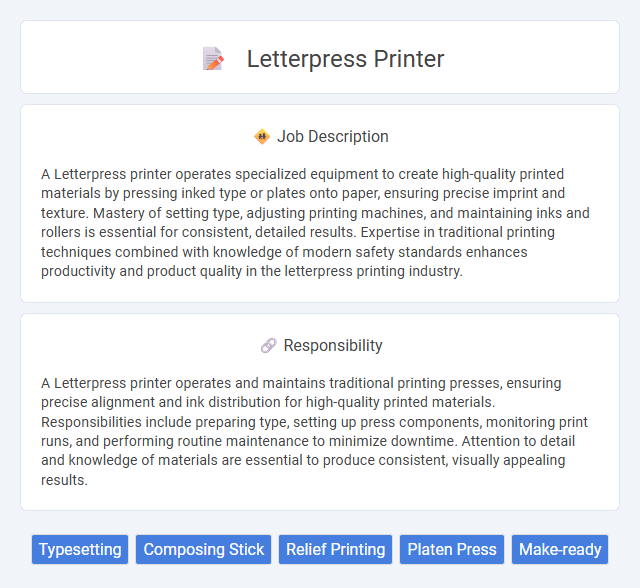
A Letterpress printer operates specialized equipment to create high-quality printed materials by pressing inked type or plates onto paper, ensuring precise imprint and texture. Mastery of setting type, adjusting printing machines, and maintaining inks and rollers is essential for consistent, detailed results. Expertise in traditional printing techniques combined with knowledge of modern safety standards enhances productivity and product quality in the letterpress printing industry.
People with strong attention to detail and patience are likely suitable for a letterpress printer job as it requires precise alignment and careful handling of materials. Those who prefer repetitive tasks and have a steady hand may find this role fitting, while individuals who struggle with fine motor skills or become easily frustrated by meticulous work might face challenges. Probable success depends on one's ability to manage the physical demands and maintain consistent quality throughout the printing process.
Qualification
A Letterpress printer must possess strong technical skills in operating and maintaining traditional letterpress machinery, including platen and cylinder presses. Proficiency in typesetting, ink mixing, and troubleshooting mechanical issues is essential for producing high-quality prints. Experience in art and design principles, along with attention to detail and manual dexterity, significantly enhances job performance and print accuracy.
Responsibility
A Letterpress printer operates and maintains traditional printing presses, ensuring precise alignment and ink distribution for high-quality printed materials. Responsibilities include preparing type, setting up press components, monitoring print runs, and performing routine maintenance to minimize downtime. Attention to detail and knowledge of materials are essential to produce consistent, visually appealing results.
Benefit
Working as a Letterpress printer probably offers unique creative satisfaction due to the tactile nature of the craft and the ability to produce high-quality, artisanal prints. It likely provides opportunities to develop specialized skills in typography and design, which can enhance employability in niche markets. Benefits may also include working in a collaborative, artistic environment where attention to detail is highly valued.
Challenge
The challenge of a Letterpress printer job likely lies in mastering the precise alignment and pressure needed to produce high-quality impressions on various paper types. Understanding the mechanics of traditional printing presses and troubleshooting frequent issues such as ink consistency or plate wear can be a demanding aspect of the role. This job probably requires a keen eye for detail and patience to ensure each print meets exacting aesthetic and technical standards.
Career Advancement
A career as a letterpress printer offers opportunities to advance through mastering intricate printing techniques and managing production workflows. Skilled letterpress printers can progress to supervisory roles, overseeing print shops or specializing in custom design and heritage print restoration. Expertise in both traditional and digital print technologies enhances prospects for leadership positions within artistic and commercial printing industries.
Key Terms
Typesetting
Letterpress printer jobs require expertise in traditional typesetting, arranging movable type to create text for printing. Mastery of hand-setting individual letters or using composing sticks ensures high-quality, precise letter alignment crucial for sharp impressions. Knowledge of letter spacing, line justification, and the physical limitations of metal type enhances the final print's clarity and aesthetic appeal.
Composing Stick
The composing stick is a fundamental tool in letterpress printing used to arrange and hold individual metal or wooden type pieces securely while setting text. Precision in adjusting the composing stick's length and spacing ensures accurate line justification and consistent type alignment, critical for high-quality prints. Mastery of the composing stick directly influences the efficiency and craftsmanship of the letterpress printing process.
Relief Printing
Letterpress printers specialize in relief printing, a traditional technique where raised surfaces are inked and pressed onto paper to create sharp, tactile impressions. Mastery of setting type and preparing plates is essential for producing high-quality prints with precise registration and deep embossing effects. This craft demands meticulous attention to detail and expertise in operating vintage presses to achieve artisanal results sought by designers and collectors.
Platen Press
Platen press operators specialize in using letterpress machines that feature a flat platen to press paper against an inked type form, ensuring precise and consistent printing of high-quality text and images. Mastery of platen press mechanics, including adjusting pressure, aligning the chase, and maintaining the ink distribution system, is essential for producing crisp, clean impressions on various paper stocks. This role demands attention to detail, understanding of typographic principles, and the ability to troubleshoot technical issues to maintain efficient operation and produce premium letterpress prints.
Make-ready
Make-ready is a critical phase in letterpress printing, involving the precise adjustment of type, plates, and blankets to ensure optimal ink distribution and impression quality. Skilled press operators meticulously align and lock the forms, control impression pressure, and fine-tune the ink rollers to achieve sharp, consistent prints. Mastery of make-ready techniques directly impacts production efficiency, print clarity, and overall project success in letterpress printing.
 kuljobs.com
kuljobs.com